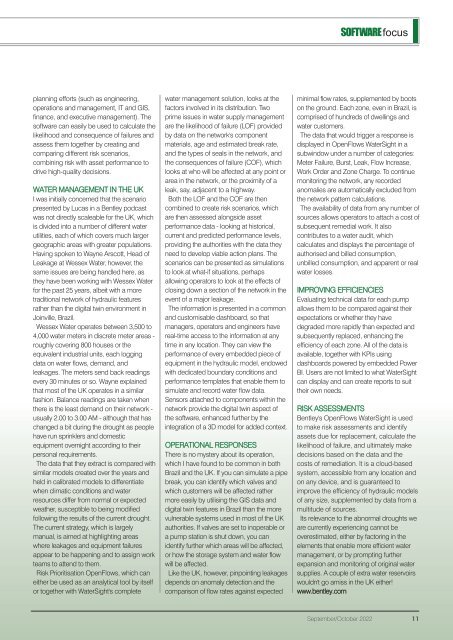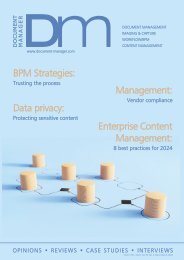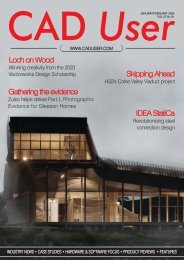CU Sep-Oct 2023
You also want an ePaper? Increase the reach of your titles
YUMPU automatically turns print PDFs into web optimized ePapers that Google loves.
SOFTWAREfocus<br />
planning efforts (such as engineering,<br />
operations and management, IT and GIS,<br />
finance, and executive management). The<br />
software can easily be used to calculate the<br />
likelihood and consequence of failures and<br />
assess them together by creating and<br />
comparing different risk scenarios,<br />
combining risk with asset performance to<br />
drive high-quality decisions.<br />
WATER MANAGEMENT IN THE UK<br />
I was initially concerned that the scenario<br />
presented by Lucas in a Bentley podcast<br />
was not directly scaleable for the UK, which<br />
is divided into a number of different water<br />
utilities, each of which covers much larger<br />
geographic areas with greater populations.<br />
Having spoken to Wayne Arscott, Head of<br />
Leakage at Wessex Water, however, the<br />
same issues are being handled here, as<br />
they have been working with Wessex Water<br />
for the past 25 years, albeit with a more<br />
traditional network of hydraulic features<br />
rather than the digital twin environment in<br />
Joinville, Brazil.<br />
Wessex Water operates between 3,500 to<br />
4,000 water meters in discrete meter areas -<br />
roughly covering 800 houses or the<br />
equivalent industrial units, each logging<br />
data on water flows, demand, and<br />
leakages. The meters send back readings<br />
every 30 minutes or so. Wayne explained<br />
that most of the UK operates in a similar<br />
fashion. Balance readings are taken when<br />
there is the least demand on their network -<br />
usually 2.00 to 3.00 AM - although that has<br />
changed a bit during the drought as people<br />
have run sprinklers and domestic<br />
equipment overnight according to their<br />
personal requirements.<br />
The data that they extract is compared with<br />
similar models created over the years and<br />
held in calibrated models to differentiate<br />
when climatic conditions and water<br />
resources differ from normal or expected<br />
weather, susceptible to being modified<br />
following the results of the current drought.<br />
The current strategy, which is largely<br />
manual, is aimed at highlighting areas<br />
where leakages and equipment failures<br />
appear to be happening and to assign work<br />
teams to attend to them.<br />
Risk Prioritisation OpenFlows, which can<br />
either be used as an analytical tool by itself<br />
or together with WaterSight's complete<br />
water management solution, looks at the<br />
factors involved in its distribution. Two<br />
prime issues in water supply management<br />
are the likelihood of failure (LOF) provided<br />
by data on the network's component<br />
materials, age and estimated break rate,<br />
and the types of seals in the network, and<br />
the consequences of failure (COF), which<br />
looks at who will be affected at any point or<br />
area in the network, or the proximity of a<br />
leak, say, adjacent to a highway.<br />
Both the LOF and the COF are then<br />
combined to create risk scenarios, which<br />
are then assessed alongside asset<br />
performance data - looking at historical,<br />
current and predicted performance levels,<br />
providing the authorities with the data they<br />
need to develop viable action plans. The<br />
scenarios can be presented as simulations<br />
to look at what-if situations, perhaps<br />
allowing operators to look at the effects of<br />
closing down a section of the network in the<br />
event of a major leakage.<br />
The information is presented in a common<br />
and customisable dashboard, so that<br />
managers, operators and engineers have<br />
real-time access to the information at any<br />
time in any location. They can view the<br />
performance of every embedded piece of<br />
equipment in the hydraulic model, endowed<br />
with dedicated boundary conditions and<br />
performance templates that enable them to<br />
simulate and record water flow data.<br />
Sensors attached to components within the<br />
network provide the digital twin aspect of<br />
the software, enhanced further by the<br />
integration of a 3D model for added context.<br />
OPERATIONAL RESPONSES<br />
There is no mystery about its operation,<br />
which I have found to be common in both<br />
Brazil and the UK. If you can simulate a pipe<br />
break, you can identify which valves and<br />
which customers will be affected rather<br />
more easily by utilising the GIS data and<br />
digital twin features in Brazil than the more<br />
vulnerable systems used in most of the UK<br />
authorities. If valves are set to inoperable or<br />
a pump station is shut down, you can<br />
identify further which areas will be affected,<br />
or how the storage system and water flow<br />
will be affected.<br />
Like the UK, however, pinpointing leakages<br />
depends on anomaly detection and the<br />
comparison of flow rates against expected<br />
minimal flow rates, supplemented by boots<br />
on the ground. Each zone, even in Brazil, is<br />
comprised of hundreds of dwellings and<br />
water customers.<br />
The data that would trigger a response is<br />
displayed in OpenFlows WaterSight in a<br />
subwindow under a number of categories:<br />
Meter Failure, Burst, Leak, Flow Increase,<br />
Work Order and Zone Charge. To continue<br />
monitoring the network, any recorded<br />
anomalies are automatically excluded from<br />
the network pattern calculations.<br />
The availability of data from any number of<br />
sources allows operators to attach a cost of<br />
subsequent remedial work. It also<br />
contributes to a water audit, which<br />
calculates and displays the percentage of<br />
authorised and billed consumption,<br />
unbilled consumption, and apparent or real<br />
water losses.<br />
IMPROVING EFFICIENCIES<br />
Evaluating technical data for each pump<br />
allows them to be compared against their<br />
expectations or whether they have<br />
degraded more rapidly than expected and<br />
subsequently replaced, enhancing the<br />
efficiency of each zone. All of the data is<br />
available, together with KPIs using<br />
dashboards powered by embedded Power<br />
BI. Users are not limited to what WaterSight<br />
can display and can create reports to suit<br />
their own needs.<br />
RISK ASSESSMENTS<br />
Bentley's OpenFlows WaterSight is used<br />
to make risk assessments and identify<br />
assets due for replacement, calculate the<br />
likelihood of failure, and ultimately make<br />
decisions based on the data and the<br />
costs of remediation. It is a cloud-based<br />
system, accessible from any location and<br />
on any device, and is guaranteed to<br />
improve the efficiency of hydraulic models<br />
of any size, supplemented by data from a<br />
multitude of sources.<br />
Its relevance to the abnormal droughts we<br />
are currently experiencing cannot be<br />
overestimated, either by factoring in the<br />
elements that enable more efficient water<br />
management, or by prompting further<br />
expansion and monitoring of original water<br />
supplies. A couple of extra water reservoirs<br />
wouldn't go amiss in the UK either!<br />
www.bentley.com<br />
<strong>Sep</strong>tember/<strong>Oct</strong>ober 2022 11

















